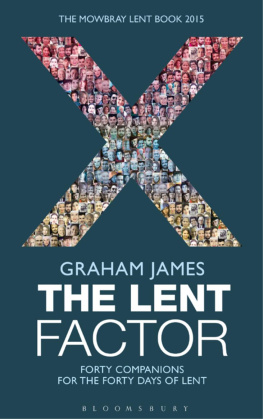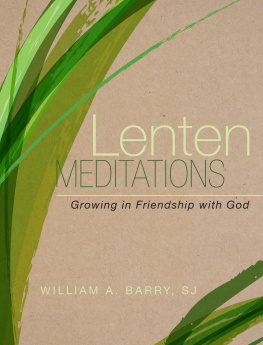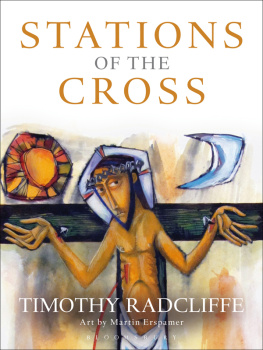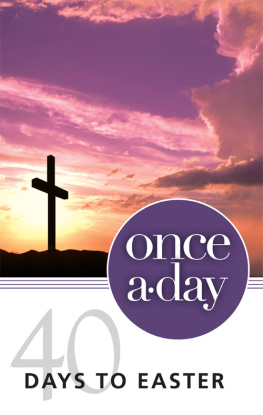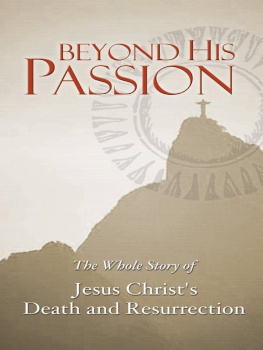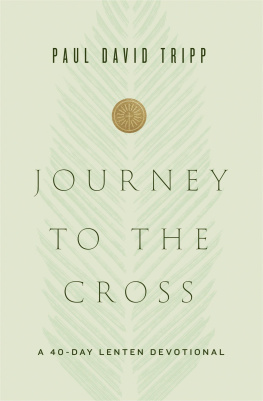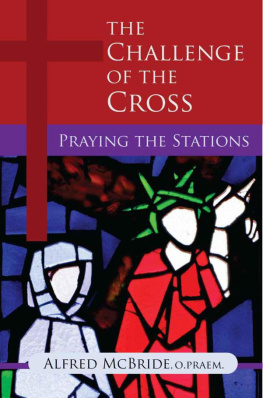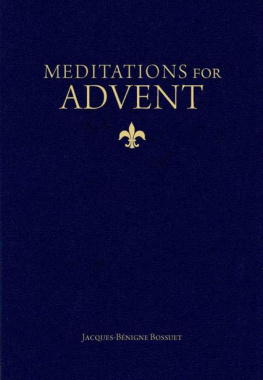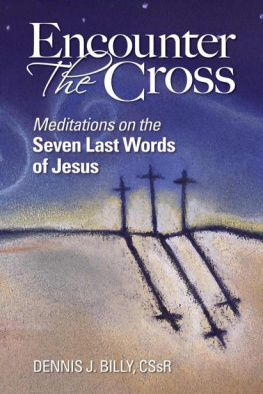The Way of the Passion
FORTY STATIONS WITH JESUS
Julien Chilcott-Monk
Library of Congress Cataloging-in-Publication Data
Chilcott-Monk, J. P.
The way of the Passion: forty stations with Jesus / Julien Chilcott-Monk.
1 online resource.
Description based on print version record and CIP data provided by publisher; resource not viewed.
ISBN 978-0-8198-8349-0 (epub) -- ISBN 978-0-8198-8350-6 (mobi) -- ISBN 978-0-8198-8351-3 (pdf) -- ISBN 978-0-8198-8348-3
1. Jesus Christ--Passion--Prayers and devotions. 2. Stations of the Cross--Prayers and devotions. 3. Lent--Prayers and devotions. 4. Passion narratives (Gospels)--Prayers and devotions. 5. Catholic Church--Prayers and devotions.
I. Title.
BT431.3
232.96--dc23
2014031814
Scripture quotations from the Revised Standard Version of the Bible, copyright 1952 [2nd edition, 1971] by the Division of Christian Education of the National Council of the Churches of Christ in the United States of America. Used by permission. All rights reserved.
Cover design by Rosana Usselmann
Cover art: Stefano Maria Legnani
All rights reserved. No part of this book may be reproduced or transmitted in any form or by any means, electronic or mechanical, including photocopying, recording, or by any information storage and retrieval system, without permission in writing from the publisher.
P and PAULINE are registered trademarks of the Daughters of Saint Paul.
Copyright 2015, Julien Chilcott-Monk
Published by Pauline Books & Media, 50 Saint Pauls Avenue, Boston, MA
02130-3491
Printed in the U.S.A.
www.pauline.org
Pauline Books & Media is the publishing house of the Daughters of Saint Paul, an international congregation of women religious serving the Church with the communications media.
1 2 3 4 5 6 7 8 9 19 18 17 16 15
To TSRH
Introduction
T his Lenten companion is intended to ignite ideas and fresh thoughts about forty episodes of the passion of our Lord. It offers a station every day throughout LentSundays are omitted, of coursefrom Ash Wednesday to Holy Saturday. The non-canonical material contained here is the result of the authors reading between the lines of the Gospel narratives and is meant to help the pilgrim focus more clearly on the events we recall ceremonially during Holy Week.
The Gospels give us only the essential details of the passion because a meticulous report of the proceedings is not the intention of the evangelists, who are concerned primarily with our Lords teaching and in establishing, in the light of the resurrection, who he is and how he fulfills Gods promise of a Savior. However, 2,000 years later we find it helpful to enter more fully into these events in order to feel something of the horror and trauma experienced by Jesus and those around him, and so grasp more easily the impact of his teaching and how our salvation was secured.
In reflecting on these daily episodes, the pilgrim can explore fresh and personal paths of contemplation by giving his or her mind free rein throughout the forty days.
To complete each session, a prompt or two is given to aid further self-examination or intercession before the more formal suggested prayers. An expanded Paternoster is given in the Appendix as an aid to fuller intercession.
The translation of the Holy Bible used in this book is the Catholic Edition of the Revised Standard Version, which, in the authors view, is still the best. In the text, quotations from the RSV are given in italics, but transliterations, conjectural speech, and the authors translations are given in Roman type.
The present tense is frequently employed in this book to give immediacy to the narrative.
JULIEN CHILCOTT-MONK
(Saint Veronicas Day)
STATION 1
The Entry into Jerusalem
Most of the crowd spread their garments on the road, and others cut branches from the trees and spread them on the road (Matthew 21:8).
J esus intended to ride on a donkey; his instructions were specific. He would ride into Jerusalem on the traditional mount of a monarch who rides to his people in peace.
The twelve disciples are now keeping pace beside the donkey. It is of no discomfort to them. They are content because the crowds are gathering. It is exciting. At last, the Master is properly acclaimed as he rides toward the capital. No need for all those predictions of gloom and suffering after all. Why, people are spreading tokens of allegiance as if before a king. Someone is crying out, Hosanna to the Son of David! (This person must know a thing or two, because King David reconciled his people by choosing Jerusalem as a neutral capital.) However, at the moment, Jesus is riding happily with his band of students. He is bantering with the crowds, always good for a joke and witty repartee. He acknowledges friends and acquaintances in the swelling body of enthusiasm. (But does he see among them the agents of Annas and Caiaphas, in little knots of dissent?)
Jesus enters the city, honored and greeted with fronds, in deep contrast to the manner in which he will shortly leave the citythrough the northwestern gate and on to the hill of Golgotha.
By means of this ride into Jerusalem our Lord is perhaps declaring: Here gathered around me are my disciples. For three years I have been preparing them with the words you have heard me preach. I bring them with me into the city from which they will emerge as my body and my Church. They are here for their final lesson and examination. This is the meaning of my journey. I come to claim my crown, but it will be a crown of sorrow and of thorns, because that is the only way in which I can lead my subjects to the kingdom of heaven. And so, take me in place of all humanity. Take me instead of accusing them, because I shall carry their sin with me.
And so the king comes to claim his crown. This journey of resolution takes Jesus to the climax of his ministry; his disciples are ready to face their trials and tests of faith. (We have knowledge of the risen Christ; at this stage, the disciples do not. We have the benefit of the Churchs teaching about these final events; at this stage, the disciples do not.) And the crown Jesus claims is, of course, the crown of thorns.
Let us consider the change in peoples hearts that transforms their Hosanna! of adulation into their Crucify! of hate.
O Heavenly Father, whose Son rode in triumph to the city of Jerusalem, mercifully assist us to understand fully the triumph of the cross and the goal of our hope in relation to the power and pleasures of our earthly desires.
Our Father Hail Mary Glory be
STATION 2
The Anointing of Jesus at Bethany
Jesus came to Bethany. There they made him a supper (John 12:18).
J ohns Gospel tells us that the anointing of Jesus takes place shortly before the entry into Jerusalem, but Matthew and Mark suggest otherwise. Only John identifies the woman with the precious ointment as Mary, the sister of Martha, whom we meet earlier in the ministry of Jesus in Lukes Gospel. There we find Mary content to sit beside Jesus while her sister busies herself with the food preparation. Martha complains to our Lord, who reassures her about the different roles people are chosen to play. Here the scene is similar: Jesus is resting at the house in Bethany, not far from Jerusalem. As before, Martha prepares and serves the food. Perhaps we can place ourselves within this scene, standing there in the light and knowledge of the resurrection. Martha sighs at the sight of her sister lazing at the feet of Jesus, hanging on his every word. On this occasion, however, she does not comment.


